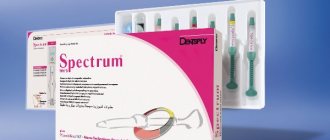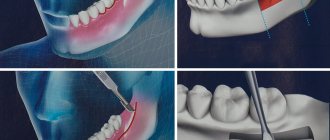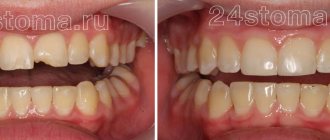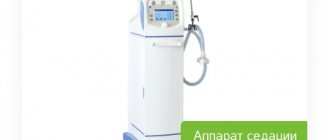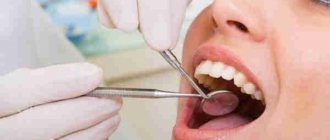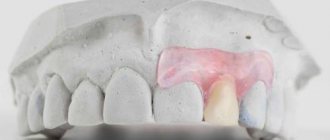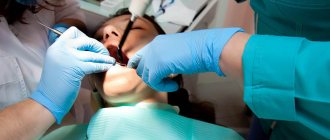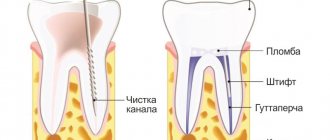What is a pin in dentistry
This is a structure in the form of a rod, which is fixed in the root canal of a destroyed tooth. It serves as an element that ensures reliable adhesion of the root system to the composite material or artificial crown. The use of such a pin allows you to restore the crown part of the tooth in the presence of a living root in satisfactory condition. Before installing such a structure, the doctor must take into account the following points:
- degree of crown destruction and the possibility of fixing the rod in the root canal,
- expected load on the tooth,
- the depth to which the rod can be immersed in the channel.
Intracanal pins are different, they are made from various materials, and the choice of a specific model directly depends on the characteristics of the clinical picture. A separate niche is occupied by anchor models - rod clamps, which can be brass, titanium, made of an alloy of gold, platinum or stainless steel. They are the most durable and allow the restoration of an almost completely destroyed tooth, ensuring long-term results, including in the area of chewing molars.
Conical fiberglass pins
For tapered fiberglass posts, retention decreases as the taper angle increases. They are most adapted in their shape and the pressure at the level of the apex of the tooth root is less significant when cementing them.
Packing: 6 pcs. / same size.
Buy Conical Fiberglass Pins
ShVS-105-0.7(K1), ShVS-120-0.8(K2), ShVS-135-0.85(K3), ShVS-150-0.9(K4), ShVS-165-0, 95(K5),ShVS-180-1.0(K6) price: 60.00 rub.
In what cases do you resort to installing an anchor rod?
If the visible part of a tooth is destroyed by more than 30%, it can be restored using filling materials, but it is not a fact that the result of such work will last long enough. By resorting to the help of an intracanal design, it is possible to achieve high adhesion strength of the restoration material or a full-fledged crown with the root system of the tooth, even if it is severely destroyed. It is important that the root canals are healthy, and then with the help of this design it is possible to save the damaged element.
The pin is used for partially destroyed teeth
Thus, anchor pins have found wide application in dental restoration in cases of destruction of varying degrees of complexity, including the almost complete absence of the external part of the element. Installation of the structure is possible if there are hard tissues at a height of at least 2-3 mm above the gum level. In addition, an x-ray must confirm the satisfactory condition of the root with a thickness of at least 2 mm1. Such a rod will ensure a more correct distribution of pressure on the tooth, restore its functionality and allow the patient to return to their normal lifestyle, without giving up solid foods.
Intra-channel gold-plated pins (ball screws)
, brass pins are widely used in many dental clinics in our country. During production, gold coating up to 3 microns thick is used.
Packing: 12pcs. / same size.
Buy gold-plated intra-channel pins (ball screws)
S1,S2,S3,S4,S5,S6, price: 38.40 rub.
M1,M2,M3,M4,M5,M6, price: 39.60 rub.
L1,L2,L3,L4,L5,L6, price: 49.20 rub.
XL1,ХL2,XL3,XL4,XL5,ХL6, price: 63.60 rub.
When installing a structure fails
It is not always possible for a specialist to install an anchor pin - there are a number of contraindications to its use. In addition to the fact that the clinical picture must meet the above requirements (2-3 mm of dental tissue above the gum level and at least 2 mm of root thickness), the patient should not have the following problems: chronic inflammatory processes in the soft tissues of the oral cavity, canal obstruction, neoplasms in the root area. Contraindications also include blood clotting disorders and disruptions in the functioning of the nervous system.
It is not possible to use with severely damaged teeth.
Set of brass gold-plated pins (ball screws)
Set No. 1 (66 pcs.)
S | 1 | 2 | 3 | 6 pcs. M | 1 | 2 | 3 | 6 pcs. L | 1 | 2 | 3 | 6 pcs. XL | 4 | 6 | 6 pcs. Cross key 1 pc. Internal key 1 pc.
Price: RUB 437.00
Set No. 2 (121 pcs.)
S | 1 | 2 | 3 | 11 pcs. M | 1 | 2 | 3 | 11 pcs. L | 1 | 2 | 3 | 11 pcs. XL | 4 | 6 | 11 pcs. Cross key 1 pc. Internal key 1 pc.
Price: 667.00 rub.
Set No. 3 (242 pcs.)
S | 1 | 2 | 3 | 22 pcs. M | 1 | 2 | 3 | 22 pcs. L | 1 | 2 | 3 | 22 pcs. XL | 4 | 6 | 22 pcs. Cross key 1 pc. Internal key 1 pc.
Price: RUB 1,265.00
What are the types of in-ear components?
There is a fairly wide variety of pins used in dentistry. Accordingly, there are several main classifications of this type of structure. Today we are talking about the anchor rod, so next we will consider its main types.
Material from which the product is made
The anchor structure can be made of various metal alloys. Based on the material of manufacture, dental experts distinguish the following types: made from an alloy of gold or platinum, titanium, brass or stainless steel. Such products are used primarily for fixing artificial crowns; they are durable and quite reliable, although today specialists increasingly prefer modifications made from more modern materials, such as fiberglass. It is also worth noting that pins can be made of ceramics (an aesthetic option), gutta-percha, carbon fiber, but they are no longer classified as anchor systems.
Products can be made from various materials
Product installation method
Intra-channel rods are also divided according to the method of installation. In this regard, experts distinguish two independent varieties:
- active - there is a thread, due to which the product is fixed by screwing into the prepared area. The disadvantage of this technique is the increased risk of damage to the canal walls as a result of excessive pressure, and this entails the need to completely remove the root system,
- passive – fixed with special dental cement. The disadvantage of this method is the possible loss of the structure after a period of operation, due to the gradual weakening of the binding properties of the composition.
The second option is used much more often, since it avoids the risk of damage to the internal structures of the tooth. If this happens, the only solution will be to implant an implant - a full-fledged analogue of a tooth root, and this is a rather serious and expensive procedure.
Shape of the rod
In-channel anchor rods come in different shapes:
- conical - in such a product the base has a larger diameter and tapers towards the end, which allows for a reliable base for fixing the crown,
- cylindrical - the design has an equal diameter along the entire length and is mainly used for wide channels,
- cylindrical-conical - the wide base gradually tapers towards the end, but does not have a point, as is the case with the conical shape.
The shape of the product can be different.
Parameters, namely the shape and size of the structure, are selected individually, based on the characteristics of each individual clinical picture. The number of roots, the nature of the canal, its depth and the degree of tooth destruction are taken into account.
What are the advantages and disadvantages?
Anchor pins have found widespread use in dentistry, and for good reason. Here are the main advantages characteristic of this type of structure:
- strength and reliability - the retainer copes well with its main function, namely holding the restored part of the tooth or an installed crown, and can withstand fairly high chewing loads,
- reasonable cost in comparison with more modern varieties of similar products,
- the speed of the procedure, which usually does not take more than an hour,
- possibility of fixing a fully functional prosthesis – an artificial crown.
However, such products today are gradually fading into the background, as experts increasingly prefer improved modifications made from modern materials. Thus, the disadvantages of anchor structures include the risk of damage to the canal walls during installation, the possible negative influence of metals, including the risk of developing an allergic reaction, poor aesthetics - over time, the metal component will begin to show through. Such products are very firmly fixed with a cement composition and are sometimes difficult to remove, hence another problem - the likelihood of root perforation.
Rehabilitation
In order for the crown structure to integrate with the gum tissue, special attention to oral hygiene after the procedure is necessary. A minimal load on the masticatory muscles is recommended. Therefore, after installing the pin, the patient eats soft pureed food for a week. To minimize the risk of inflammation of the gums and canals, teeth are brushed after each meal using dental floss.
Often, after installing the pin, the patient complains of pain in the manipulation area and slight swelling of the mucous membrane. Doctors at the NovaDent clinic remind you that discomfort during the first 48 hours after the procedure is normal. After two days, the pain will go away and the patient will evaluate the result of the treatment.
How to install a pin - description of technology
After all the preparatory measures, diagnosis and choice of treatment tactics, the doctor proceeds directly to the procedure. To begin with, adjacent teeth are isolated, old filling material or tissues affected by caries are removed, the dental canal is treated and prepared, it is expanded if necessary, as well as complete antiseptic treatment of the tissues. This is usually followed by fitting - the doctor fixes the temporary product and directs the patient to take a picture to make sure that the element is installed in the correct position and to the required depth. If all is well, the temporary structure is removed and a permanent one is installed.
The photo shows a pin installed in a tooth.
The rod itself is carefully placed in the root canal using a special key, which is usually supplied in the kit. The threaded model is screwed in with extreme care to avoid damage to the canal walls. The passive variation is less demanding in this regard, and a cement composition is used for its reliable fixation. The tip of the rod remains above the gum line and serves as the basis for fixing the crown. All manipulations are performed under local anesthesia.
As for whether it is realistic to remove the anchor pin, the answer is yes, but with a caveat: the product is successfully removed using ultrasound, which destroys the binding properties of the cement, but there remains a fairly high risk of severe damage to the root. If this happens, it will have to be removed and subsequently implanted, and this is a much more expensive and serious procedure.
Stages of installation of the structure
Before placing a pin in a tooth, you need to prepare the canals and eliminate contraindications. If you plan to install an intracanal pin, then you need to completely remove the nerve and affected tissue, and cure the inflammation under the roots. And then carry out obturation - closing the canals with special filling compounds. Before installing the parapulp structure, the areas of enamel and dentin affected by caries should be carefully drilled out. In any case, preparation is accompanied by x-ray control - this is how the condition of the pulp and ligamentous apparatus is assessed, cysts and granulomas are identified, and the quality of obturation is determined.
After the preparatory stage, you can begin to install the structure. How is a pin screwed into a tooth and does it hurt? There shouldn't be any pain, because... treatment is carried out with an injection of anesthetic. Or on a previously pulpless root without an injection, because the tooth is already “dead”, i.e. there is no nerve in it that would respond to stimuli. The pin is inserted after part of the filling compound is removed from the top of the canal - approximately 2/3 is removed, and the lower third remains hermetically sealed. Here, special reamers are used that give the channel a conical or cylindrical shape.
Alternative restoration options
Many dentists today try to avoid anchors because they now have more modern and reliable products at their disposal that do not have many of the disadvantages inherent in metal rods. The priority is ceramics for the front teeth, as well as fiberglass - a durable and fairly elastic material that can withstand high loads, but without compromising the aesthetic component. Among the advantages of fiberglass products are the following:
- no risk of allergies,
- simple and safe installation,
- preservation of the walls of the root canal in the long term,
- ease of removal of the structure, and the possibility of its return in place after treatment,
- the ability to achieve high aesthetics during restoration,
- strength and reliability.
Fiberglass pin makes it possible to achieve high aesthetics in prosthetics
“I had one of my front teeth restored, and the doctor immediately said that it would be better to use a fiberglass pin. It is ideal for the smile area, does not show through over time, and holds firmly. In my case, the result exceeded all my expectations - the tooth is exactly the same as all the others, I don’t notice any differences. About a year passed and no visible changes occurred. And I’ve never heard of an allergy to fiberglass...”
Olga, from correspondence on the woman.ru forum
Fiberglass is absolutely resistant to the aggressive external environment of the oral cavity. In addition, this is an excellent option if the restoration is carried out without the use of prosthetic products, namely with the help of composite materials - the fibers have a matte white color, so they will not show through the composite and thereby spoil the appearance of the smile. Installation is less traumatic, and the risk of root damage remains minimal.
Expanding tetrahedral drill (DDR)
Expanding tetrahedral drill (FDR), made of stainless steel, is used to form a tooth channel before installing brass and fiberglass pins
Packing: 1 pc.
Buy expansion tetrahedral drill (DDR)
DRCH-1.06-19.00 for S1, M1, L1, XL1, ShVS 105 (L1), price: 81.00 rub.
DRCh-1.21-19.00 for S2, M2, L2, XL2, ShVS 120 (L2), price: 81.00 rub.
DRCh-1.36-19.00 for S3, MZ, L3, XL3, ShVS 135 (L3), price: 81.00 rub.
DRCH-1.52-19.00 for S4, M4, L4, XL4, ShVS 150 (L4), price: 81.00 rub.
DRCh-1.67-19.00 for S5, M5, L5, XL5, ShVS 165 (L5), price: 81.00 rub.
DRCh-1.82-19.00 for S6, M6, L6, XL6, ShVS 180 (L6), price: 81.00 rub.
Possible complications
Installation of the anchor pin is usually quick and without complications. Problems may arise due to the patient's allergy to metals. In such a situation, swelling usually develops, the gums in the area of the restored tooth turn red, and itching appears. If such symptoms are detected, you should immediately contact your dentist to remove the structure. If a specialist made mistakes during the treatment process or carried out insufficiently high-quality antiseptic treatment, there may be a risk of developing an inflammatory process - stomatitis, periodontitis.
Swelling after treatment may be a sign of complications
Immediately after the procedure, when the anesthesia wears off, discomfort and moderate pain may appear - this is a completely natural phenomenon, a reaction to tissue injury that inevitably occurs during root canal treatment and restoration of a damaged tooth. The symptoms will go away after a couple of days, but in the meantime, pharmaceutical painkillers will help alleviate the condition. If the pain and intensity of symptoms only increases, it is better to see a specialist. Perhaps the whole point is damage to the walls of the root canal.
How does the installation work?
Immediately after the question: “How much does a tooth cost on a pin,” patients are interested in the process itself. The most important point: you can add a crown to a neglected tooth only after filling (and sometimes pre-treatment) the canals.
Pin installation steps:
- Expansion of the dental canal with chemicals. The process is painless and takes a couple of minutes.
- Fixation of the structure with cement material and/or by screwing in threads (anchors).
- Installation of a crown or prosthetic bridge.
Restoring a tooth with a fiberglass pin takes up to an hour. To minimize discomfort during the procedure, painkillers are used.
Care after installation
After the restoration, the specialist will definitely give detailed recommendations regarding care during rehabilitation and recovery. So, for about a week it is better to stop eating solid foods and using toothpicks.
In the future, care should be taken to treat the restored tooth, trying to protect it from excessive mechanical loads and traumatic factors. An important condition is responsible adherence to the rules of hygiene: regular brushing of teeth twice every day, rinsing the mouth after meals, systematic visits to the dentist for preventive examinations.
Proper dental hygiene is important to maintain your smile.
How much does an anchor pin cost?
This type of rod refers to financially affordable solutions. Installation of a stainless steel structure will cost the patient an average of 400 rubles. If the product is made of titanium, the price will increase to approximately 600 rubles. Titanium rods with gold plating cost about 800-1000 rubles. You need to understand that this is only the cost of the structure itself and its installation. Tooth restoration will require additional costs for x-ray examination, anesthesia, canal treatment and filling, possibly depulpation if it has not been carried out previously, as well as restoration with composite materials or the manufacture and installation of a crown.
An anchor pin is a reliable and proven solution that allows you to restore even a severely damaged tooth and fully restore its functionality. However, today many dentists are inclined to use rods made of more modern and aesthetic materials, which are often not inferior to metal structures in terms of strength and service life. In any case, the choice of one type of product or another should be based on the individual characteristics of the clinical picture, so it is better to entrust this task to a specialist.
- Adialkhanyan V.A. Features of tooth restoration after endodontic treatment, 2003.
Advantages of installing titanium pins
There are several types of pins, but titanium ones have a number of competitive advantages. Their main advantage is their impressive service life, which with proper care can exceed 10 years.
The titanium design allows you to completely hide the external manifestation of the resulting defect, as well as restore the previous functionality of the tooth. Such pins are often installed under the crown, significantly reducing the process of its abrasion. This effect is achieved due to the fact that the titanium support evenly distributes the load during chewing.
Please note that pins can only be used when restoring a tooth for the first time. For repeated manipulations, dentists recommend choosing a different treatment method.


